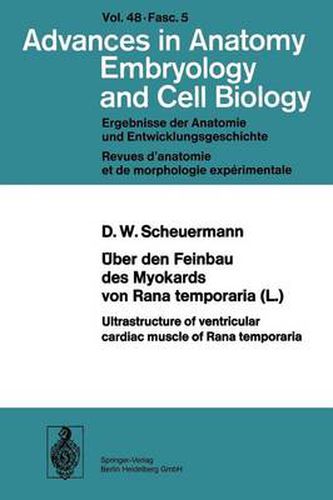Readings Newsletter
Become a Readings Member to make your shopping experience even easier.
Sign in or sign up for free!
You’re not far away from qualifying for FREE standard shipping within Australia
You’ve qualified for FREE standard shipping within Australia
The cart is loading…






This title is printed to order. This book may have been self-published. If so, we cannot guarantee the quality of the content. In the main most books will have gone through the editing process however some may not. We therefore suggest that you be aware of this before ordering this book. If in doubt check either the author or publisher’s details as we are unable to accept any returns unless they are faulty. Please contact us if you have any questions.
Die Ergebnisse der elektronenmikroskopischen Untersuchungen von Ventri- keln des Myokards verschiedener Wirbeltiere zeigen nach den bis heute angewand- ten Methoden, dass es erhebliche Unterschiede einerseits zwischen dem Herz- muskel der Fische, Amphibien und Reptilien und andererseits dem der Sauge- tiere gibt. Die Herzmuskelzellen der Kaltbluter weisen ein kaum entwickeltes sarko- plasmatisches Reticulum (SR) auf (Frosch: Scheyer, 1960; Huang, 1967; Staley und Benson, 1968; Sommer und Johnson, 1969, 1970; Axolotl: Howse et al., 1969; Gros und SchrEwel, 1970; Schildkrote: Fawcett und Selby, 1958; Bergman, 1960; Boa constrictor: Leak, 1967). Sie besitzen kein transversales tubulares System (T-System) (Frosch: Staley und Benson, 1968; Sommer und Johnson, 1969, 1970; Axolotl: Howse et al., 1969; Gros und SchrEwel, 1970; Schildkroten, Salamander, Fische: Howse et al., 1970; Schildkrote: Hirakow, 1970; Necturus: Hirakow, 1971; Boa constrictor: Leak, 1967), und es fehlt der Nexus zwischen den Myokard- zellen (Frosch: Staley und Benson, 1968; Sommer und Johnson, 1969, 1970; Axolotl: Howse et al., 1969; Gros und Schnlvel, 1970).
$9.00 standard shipping within Australia
FREE standard shipping within Australia for orders over $100.00
Express & International shipping calculated at checkout
This title is printed to order. This book may have been self-published. If so, we cannot guarantee the quality of the content. In the main most books will have gone through the editing process however some may not. We therefore suggest that you be aware of this before ordering this book. If in doubt check either the author or publisher’s details as we are unable to accept any returns unless they are faulty. Please contact us if you have any questions.
Die Ergebnisse der elektronenmikroskopischen Untersuchungen von Ventri- keln des Myokards verschiedener Wirbeltiere zeigen nach den bis heute angewand- ten Methoden, dass es erhebliche Unterschiede einerseits zwischen dem Herz- muskel der Fische, Amphibien und Reptilien und andererseits dem der Sauge- tiere gibt. Die Herzmuskelzellen der Kaltbluter weisen ein kaum entwickeltes sarko- plasmatisches Reticulum (SR) auf (Frosch: Scheyer, 1960; Huang, 1967; Staley und Benson, 1968; Sommer und Johnson, 1969, 1970; Axolotl: Howse et al., 1969; Gros und SchrEwel, 1970; Schildkrote: Fawcett und Selby, 1958; Bergman, 1960; Boa constrictor: Leak, 1967). Sie besitzen kein transversales tubulares System (T-System) (Frosch: Staley und Benson, 1968; Sommer und Johnson, 1969, 1970; Axolotl: Howse et al., 1969; Gros und SchrEwel, 1970; Schildkroten, Salamander, Fische: Howse et al., 1970; Schildkrote: Hirakow, 1970; Necturus: Hirakow, 1971; Boa constrictor: Leak, 1967), und es fehlt der Nexus zwischen den Myokard- zellen (Frosch: Staley und Benson, 1968; Sommer und Johnson, 1969, 1970; Axolotl: Howse et al., 1969; Gros und Schnlvel, 1970).